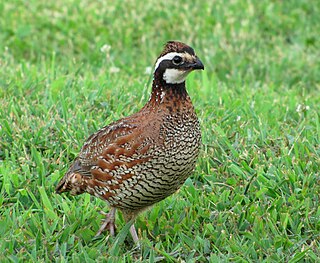
The New World quail are small birds, that despite their similar appearance and habits to the Old World quail, belong to a different family known as the Odontophoridae. In contrast, the Old World quail are in the Phasianidae family. The geographical range of the New World quail extends from Canada to southern Brazil, and two species, the California quail and the bobwhite quail, have been successfully introduced to New Zealand. The stone partridge and Nahan's partridge, both found in Africa, seem to belong to the family. Species are found across a variety of habitats from tropical rainforest to deserts, although few species are capable of surviving at very low temperatures. There are 34 species divided into 10 genera.
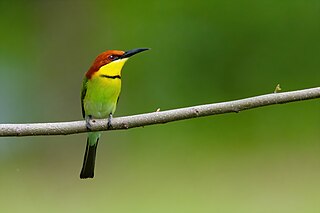
The chestnut-headed bee-eater, or bay-headed bee-eater, is a bird in the bee-eater family Meropidae. It breeds on the Indian subcontinent and adjoining regions, ranging from India east to Southeast Asia.

Tragopan is a bird genus in the pheasant family Phasianidae. Member of the genus are commonly called "horned pheasants" because males have two brightly colored, fleshy horns on their head that can be erected during courtship displays. The habit of tragopans to nest in trees is unique among phasianids.

Nyctibius is a genus of potoos, nocturnal birds in the family Nyctibiidae.
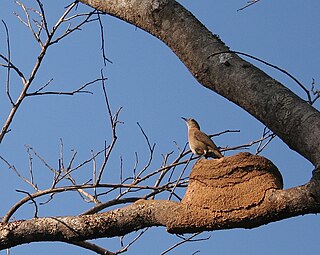
The hornero birds are members of the genus Furnarius in the family Furnariidae, native to South America. The English common name appears in many books as "ovenbird".

The plumbeous kite is a bird of prey in the family Accipitridae that is resident in much of northern South America. It is migratory in the northern part of its range which extends north to Mexico. It feeds on insects which it catches either from a perch or while in flight.

The white-lined tanager is a medium-sized passerine bird in the tanager family Thraupidae. It is a resident breeder from Costa Rica south to northern Argentina and on the islands of Trinidad and Tobago.

The great antshrike is a passerine bird in the antbird family, Thamnophilidae. It is the only member of the genus Taraba. It is a resident breeder in the tropical New World in southern Mexico, Central America, Trinidad and South America down to northern Argentina and southeastern Brazil.

Perdix is a genus of Galliform gamebirds known collectively as the 'true partridges'. These birds are unrelated to the subtropical species that have been named after the partridge due to similar size and morphology.
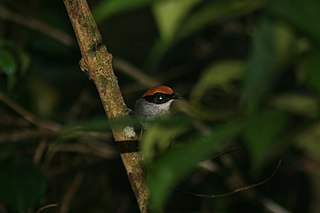
Conopophaga is a genus of birds in the gnateater family. Its members are found in forest and woodland in South America.

The spotted wood quail is a small ground-dwelling bird in the New World quail family. It is a resident breeder in the mountains of Central America from southern Mexico to western Panama.
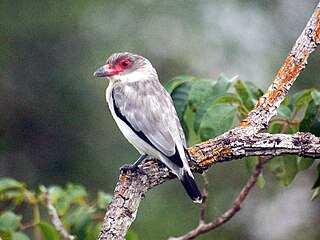
The tityras are passerine birds in the genus Tityra of the family Tityridae. They are found from southern Mexico, through Central America, to northern and central South America, including Trinidad.

The crimson-headed partridge is a species of bird in the pheasant, partridge, and francolin family Phasianidae. Described by the British ornithologist Richard Bowdler Sharpe in 1879, it is the only species in the genus Haematortyx. It is endemic to Borneo, where it inhabits lower montane forest in the northern and central parts of the island. It is mainly found at elevations of 1,000–1,700 m (3,300–5,600 ft), but can be seen as low as 185 m (607 ft) and as high as 3,050 m (10,010 ft). Adult males have a striking appearance, with a dark blackish body and crimson red heads, necks, breasts, and undertail coverts. Females have a similar pattern, but with duller brownish-black colouration, orangish-red heads and breasts, and a brownish-black bill instead of a yellowish one. Juveniles are duller and have the crimson restricted to the top of the head.

The spot-winged wood quail is a species of bird in the family Odontophoridae. It is found in Brazil, Argentina and Paraguay, and formerly in Uruguay. In Portuguese and Spanish the bird is called uru.

The marbled wood quail, also known as the Amazonian wood quail, is a species of bird in the New World quail family. It has an extensive distribution in Central America and the northern part of South America. Its natural habitat is subtropical or tropical moist lowland forests.

The black-breasted wood quail is a bird species in the family Odontophoridae. It is found in Costa Rica and Panama. Its natural habitat is subtropical or tropical moist montane forest.

The dark-backed wood quail is a bird species in the family Odontophoridae, which is the New World quail. It is found in Colombia and Ecuador.

The black-eared wood quail is a bird species in the order Galliformes. Until recently, the species was thought to be part of the family Phasianidae however DNA-DNA hybridization results determined that black-eared wood quail are only distantly related to Old World quail. As a result, black-eared wood quail have been placed in the family Odontophoridae and more specifically, in the category of wood quail.

The starred wood quail is a species of bird in the family Odontophoridae. It is found in subtropical or tropical moist lowland forests of Bolivia, Brazil, Ecuador, and Peru.
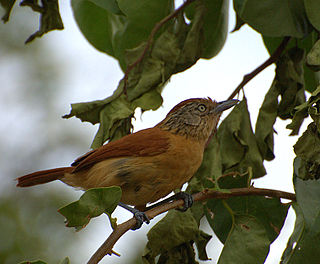
Thamnophilus is a genus of antbird in the antbird family, Thamnophilidae. The species in this genus are commonly known as antshrikes. They are insectivores that feed by gleaning prey from foliage and are found in the Neotropics.





























